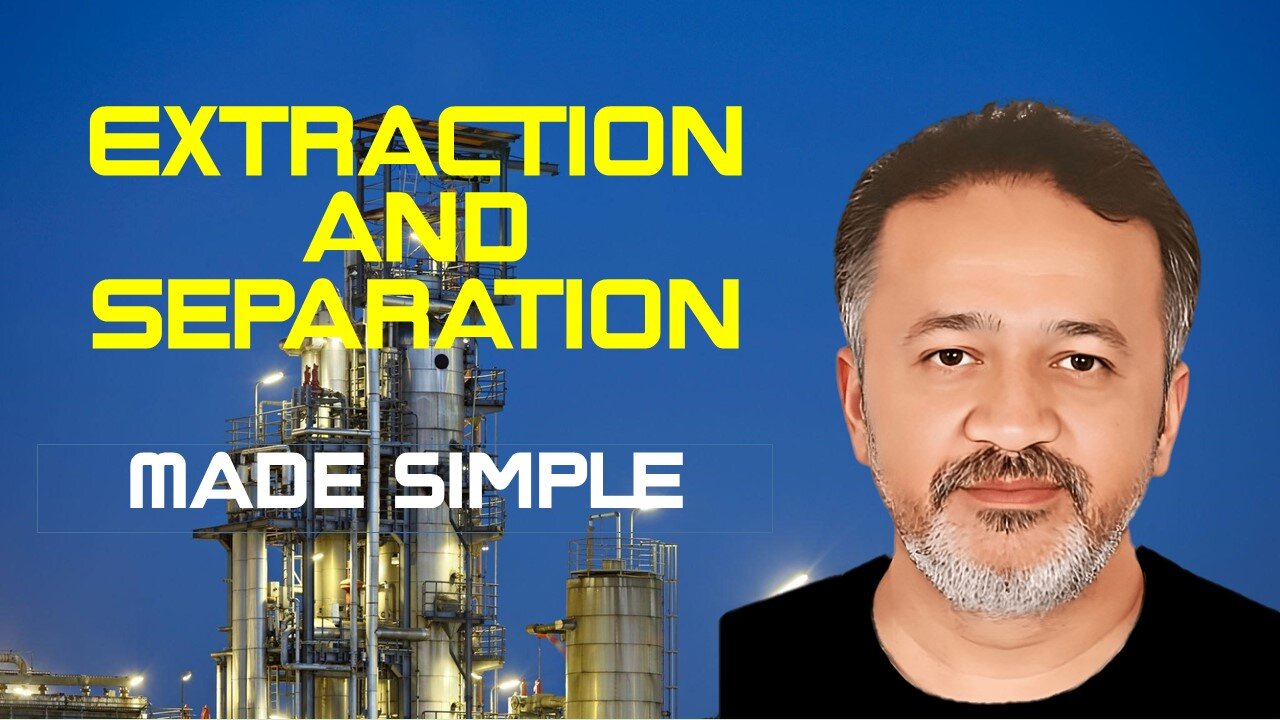Premium Only Content

Separation and Extraction: Exploring Techniques and Applications| Demystifying Separation Equipment
Separation and extraction are essential processes used to separate and isolate components from mixtures or solutions based on their physical or chemical properties. These processes play a crucial role in various industries, including chemical processing, pharmaceuticals, food and beverage, oil and gas, and environmental engineering.
Separation:
Separation involves the isolation of different components or phases from a mixture. It is employed when there are distinct differences in the physical or chemical properties of the substances present. Some common separation techniques include:
Distillation: Distillation is a process that separates components based on their different boiling points. By heating the mixture, the component with the lower boiling point vaporizes first and is then condensed to obtain a purified substance.
Filtration: Filtration is used to separate solid particles from liquids or gases by passing the mixture through a porous medium, such as a filter or sieve. The solid particles are retained, while the liquid or gas passes through.
Centrifugation: Centrifugation utilizes centrifugal force to separate components with different densities. The mixture is spun rapidly, causing heavier components to settle at the bottom, while lighter components remain in the supernatant.
Extraction: Extraction involves selectively removing a component from a mixture using a suitable solvent. The solvent extracts the desired component, leaving behind the rest of the mixture. Extraction is widely used in industries such as pharmaceuticals, food processing, and environmental remediation.
Extraction:
Extraction is a process that aims to selectively separate one or more desired substances from a mixture or matrix. It involves dissolving the desired component(s) into a solvent that has an affinity for the target substance. Some common extraction techniques include:
Liquid-Liquid Extraction: Liquid-liquid extraction involves the transfer of a solute from one liquid phase (the source phase) into another liquid phase (the solvent phase) that is immiscible with the source phase. This technique is often used for purification and isolation of specific compounds.
Solid-Phase Extraction: Solid-phase extraction involves passing a liquid mixture through a solid material or sorbent, which selectively retains the desired substance. The unwanted components are washed away, and the desired substance is later eluted for further analysis or use.
Supercritical Fluid Extraction: Supercritical fluid extraction utilizes a supercritical fluid, typically carbon dioxide, which exhibits properties between a gas and a liquid, as the solvent. This technique is useful for extracting compounds that are sensitive to high temperatures or require specific solvents.
Microwave-Assisted Extraction: Microwave-assisted extraction involves applying microwave energy to enhance the extraction process. It can improve the efficiency and speed of extraction, particularly for heat-sensitive compounds.
Separation and extraction processes are crucial for obtaining purified substances, isolating valuable components, removing impurities, and analyzing or utilizing specific compounds. These processes enable industries to obtain high-quality products, perform accurate analyses, and ensure compliance with regulatory standards. They contribute significantly to advancements in various fields, including pharmaceutical development, environmental monitoring, chemical synthesis, and food production.
-
 LIVE
LIVE
The Jimmy Dore Show
1 hour agoGaza Ceasefire Is ON — But Will It Hold? Trump CONSIDERING Ghislaine Maxwell Pardon! w/ Ian Carroll
4,557 watching -
 LIVE
LIVE
Stephen Gardner
33 minutes ago🔥Trump's 2 HUGE wins the media REFUSES to report!
515 watching -
 LIVE
LIVE
Dr Disrespect
8 hours ago🔴LIVE - DR DISRESPECT - BATTLEFIELD 6 - THE WAR BEGINS | BF6 LAUNCH DAY
1,963 watching -
 LIVE
LIVE
Nerdrotic
2 hours agoTron: Ovaries! | Peacemaker GUNNS Down DCU | Hollywood Death Spiral | Friday Night Tights 375
1,533 watching -
 LIVE
LIVE
LFA TV
18 hours agoLIVE & BREAKING NEWS! | FRIDAY 10/10/25
1,182 watching -
 1:09:03
1:09:03
vivafrei
4 hours agoCriminals Are Getting Nervous! Democrats Can't Give Trump Credit! AND MORE!
72.4K27 -
 12:56
12:56
Dr. Nick Zyrowski
8 days agoFasting Is THE Cure: No Food For 2 Days Is The Perfect Fast! (Here’s Why)
6.3K4 -
![MAHA News [10.10]: Cannabis Reform, Kennedy Exposes "Vaccines Saved Lives", An Inconvenient Study](https://1a-1791.com/video/fwe2/09/s8/1/-/k/v/p/-kvpz.0kob-small-MAHA-News-10.10.jpg) LIVE
LIVE
Badlands Media
17 hours agoMAHA News [10.10]: Cannabis Reform, Kennedy Exposes "Vaccines Saved Lives", An Inconvenient Study
490 watching -
 1:51:23
1:51:23
The Quartering
5 hours agoTrump Snub Backfires, Matt Walsh Sounds The Alarm, Candace Owens Theory On Charlie Kirk
104K46 -
 LIVE
LIVE
Owen Shroyer
1 hour agoOwen Report - 10-10-2025 - Qatari Airbase In America Angers Israeli Lobby
1,257 watching